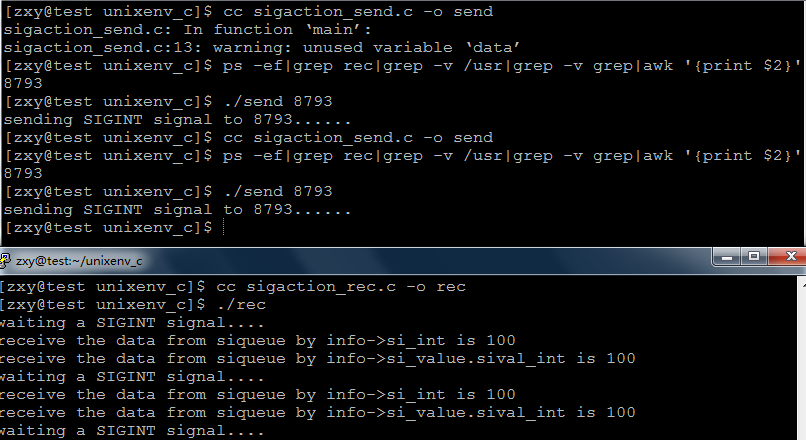linux系統編程之信號(六):信號發送函數sigqueue和信號安裝函數sigaction
一,sigaction()
#include <signal.h>
int sigaction(int signum,const struct sigaction *act,struct sigaction *oldact));
sigaction函數用於改變進程接收到特定信號後的行為。該函數的第一個參數為信號的值,可以為除SIGKILL及SIGSTOP外的任何一個特定有效的信號(為這兩個信號定義自己的處理函數,將導致信號安裝錯誤)。第二個參數是指向結構sigaction的一個實例的指針,在結構sigaction的實例中,指定了對特定信號的處理,可以為空,進程會以缺省方式對信號處理;第三個參數oldact指向的對象用來保存原來對相應信號的處理,可指定oldact為NULL。如果把第二、第三個參數都設為NULL,那麼該函數可用於檢查信號的有效性。
第二個參數最為重要,其中包含了對指定信號的處理、信號所傳遞的信息、信號處理函數執行過程中應屏蔽掉哪些函數等等。
sigaction結構定義如下:
struct sigaction {
union {
__sighandler_t _sa_handler;
void (*_sa_sigaction)(int, struct siginfo*, void*);
} _u
sigset_t sa_mask;
unsigned long sa_flags;
void (*sa_restorer)(void);
}
其中,sa_restorer,已過時,POSIX不支持它,不應再被使用。
1、聯合數據結構中的兩個元素_sa_handler以及*_sa_sigaction指定信號關聯函數,即用戶指定的信號處理函數。除了可以是用戶自定義的處理函數外,還可以為SIG_DFL(採用缺省的處理方式),也可以為SIG_IGN(忽略信號)。
2、由_sa_handler指定的處理函數只有一個參數,即信號值,所以信號不能傳遞除信號值之外的任何信息;由_sa_sigaction是指定的信號處理函數帶有三個參數,是為實時信號而設的(當然同樣支持非實時信號),它指定一個3參數信號處理函數。第一個參數為信號值,第三個參數沒有使用(posix沒有規範使用該參數的標準),第二個參數是指向siginfo_t結構的指針,結構中包含信號攜帶的數據值,參數所指向的結構如下:
typedef struct siginfo_t {
int si_signo;//信號編號
int si_errno;//如果為非零值則錯誤代碼與之關聯
int si_code;//說明進程如何接收信號以及從何處收到
pid_t si_pid;//適用於SIGCHLD,代表被終止進程的PID
pid_t si_uid;//適用於SIGCHLD,代表被終止進程所擁有進程的UID
int si_status;//適用於SIGCHLD,代表被終止進程的狀態
clock_t si_utime;//適用於SIGCHLD,代表被終止進程所消耗的用戶時間
clock_t si_stime;//適用於SIGCHLD,代表被終止進程所消耗系統的時間
sigval_t si_value;
int si_int;
void* si_ptr;
void* si_addr;
int si_band;
int si_fd;
};
siginfo_t結構中的聯合數據成員確保該結構適應所有的信號,比如對於實時信號來說,則實際採用下面的結構形式:
typedef struct {
int si_signo;
int si_errno;
int si_code;
union sigval si_value;
} siginfo
結構的第四個域同樣為一個聯合數據結構:
union sigval {
int sival_int;
void* sival_ptr;
}
採用聯合數據結構,說明siginfo_t結構中的si_value要麼持有一個4字節的整數值,要麼持有一個指針,這就構成了與信號相關的數據。在信號的處理函數中,包含這樣的信號相關數據指針,但沒有規定具體如何對這些數據進行操作,操作方法應該由程序開發人員根據具體任務事先約定。
sigval結構體:系統調用sigqueue發送信號時,sigqueue的第三個參數就是sigval聯合數據結構,當調用sigqueue時,該數據結構中的數據就將拷貝到信號處理函數的第二個參數中。這樣,在發送信號同時,就可以讓信號傳遞一些附加信息。信號可以傳遞信息對程序開發是非常有意義的。
siginfo_t.si_value與sigqueue(pid_t pid, int sig, const union sigval val)第三個參數關聯即:
所以通過siginfo_t.si_value可以獲得sigqueue(pid_t pid, int sig, const union sigval val)第三個參數傳遞過來的數據。
如:siginfo_t.si_value.sival_int或siginfo_t.si_value.sival_ptr
其實siginfo_t.si_int直接與sigval.sival_int關聯
siginfo_t.si_ptr直接與sigval.sival_ptr關聯,所以也可同這種方式獲得sigqueue發送過來的數據。
信號參數的傳遞過程可圖示如下:
3、sa_mask指定在信號處理程序執行過程中,哪些信號應當被阻塞。缺省情況下當前信號本身被阻塞,防止信號的嵌套發送,除非指定SA_NODEFER或者SA_NOMASK標誌位,處理程序執行完後,被阻塞的信號開始執行。
注:請注意sa_mask指定的信號阻塞的前提條件,是在由sigaction()安裝信號的處理函數執行過程中由sa_mask指定的信號才被阻塞。
4、sa_flags中包含了許多標誌位,包括剛剛提到的SA_NODEFER及SA_NOMASK標誌位。另一個比較重要的標誌位是SA_SIGINFO,當設定了該標誌位時,表示信號附帶的參數可以被傳遞到信號處理函數中,因此,應該為sigaction結構中的sa_sigaction指定處理函數,而不應該為sa_handler指定信號處理函數,否則,設置該標誌變得毫無意義。即使為sa_sigaction指定了信號處理函數,如果不設置SA_SIGINFO,信號處理函數同樣不能得到信號傳遞過來的數據,在信號處理函數中對這些信息的訪問都將導致段錯誤(Segmentation fault)。
注:很多文獻在闡述該標誌位時都認為,如果設置了該標誌位,就必須定義三參數信號處理函數。實際不是這樣的,驗證方法很簡單:自己實現一個單一參數信號處理函數,並在程序中設置該標誌位,可以察看程序的運行結果。實際上,可以把該標誌位看成信號是否傳遞參數的開關,如果設置該位,則傳遞參數;否則,不傳遞參數。
##二,sigqueue()
之前學過kill,raise,alarm,abort等功能稍簡單的信號發送函數,現在我們學習一種新的功能比較強大的信號發送函數sigqueue.
#include <sys/types.h>
#include <signal.h>
int sigqueue(pid_t pid, int sig, const union sigval val)
調用成功返回 0;否則,返回 -1。
sigqueue()是比較新的發送信號系統調用,主要是針對實時信號提出的(當然也支持前32種),支持信號帶有參數,與函數sigaction()配合使用。
sigqueue的第一個參數是指定接收信號的進程ID,第二個參數確定即將發送的信號,第三個參數是一個聯合數據結構union sigval,指定了信號傳遞的參數,即通常所說的4字節值。
typedef union sigval {
int sival_int;
void* sival_ptr;
} sigval_t;
sigqueue()比kill()傳遞了更多的附加信息,但sigqueue()只能向一個進程發送信號,而不能發送信號給一個進程組。如果signo=0,將會執行錯誤檢查,但實際上不發送任何信號,0值信號可用於檢查pid的有效性以及當前進程是否有權限向目標進程發送信號。
在調用sigqueue時,sigval_t指定的信息會拷貝到對應sig 註冊的3參數信號處理函數的siginfo_t結構中,這樣信號處理函數就可以處理這些信息了。由於sigqueue系統調用支持發送帶參數信號,所以比kill()系統調用的功能要靈活和強大得多。
##三,sigqueue與sigaction應用實例 實例一:利用sigaction安裝SIGINT信號
#include <unistd.h>
#include <sys/stat.h>
#include <sys/wait.h>
#include <sys/types.h>
#include <fcntl.h>
#include <stdlib.h>
#include <stdio.h>
#include <errno.h>
#include <string.h>
#include <signal.h>
#define ERR_EXIT(m) \
do \
{ \
perror(m); \
exit(EXIT_FAILURE); \
} while(0)
void handler(int sig);
int main(int argc, char *argv[])
{
struct sigaction act;
act.sa_handler = handler;
sigemptyset(&act.sa_mask);
act.sa_flags = 0;
//因為不關心SIGINT上一次的struct sigaction所以,oact為NULL
//與signal(handler,SIGINT)相同
if (sigaction(SIGINT, &act, NULL) < 0)
ERR_EXIT("sigaction error\n");
for (;;)
pause();
return 0;
}
void handler(int sig)
{
printf("recv a sig=%d\n", sig);
}
結果:
實例二:利用sigaction實現signal,實際上signal底層實現就是利用sigaction
#include <unistd.h>
#include <sys/stat.h>
#include <sys/wait.h>
#include <sys/types.h>
#include <fcntl.h>
#include <stdlib.h>
#include <stdio.h>
#include <errno.h>
#include <string.h>
#include <signal.h>
#define ERR_EXIT(m) \
do \
{ \
perror(m); \
exit(EXIT_FAILURE); \
} while(0)
void handler(int sig);
__sighandler_t my_signal(int sig, __sighandler_t handler);
int main(int argc, char *argv[])
{
my_signal(SIGINT, handler);
for (;;)
pause();
return 0;
}
__sighandler_t my_signal(int sig, __sighandler_t handler)
{
struct sigaction act;
struct sigaction oldact;
act.sa_handler = handler;
sigemptyset(&act.sa_mask);
act.sa_flags = 0;
if (sigaction(sig, &act, &oldact) < 0)
return SIG_ERR;
return oldact.sa_handler;
}
void handler(int sig)
{
printf("recv a sig=%d\n", sig);
}
結果:
可知my_signal與系統調用signal具有相同的效果
實例三:驗證sigaction.sa_mask效果
#include <unistd.h>
#include <sys/stat.h>
#include <sys/wait.h>
#include <sys/types.h>
#include <fcntl.h>
#include <stdlib.h>
#include <stdio.h>
#include <errno.h>
#include <string.h>
#include <signal.h>
#define ERR_EXIT(m) \
do \
{ \
perror(m); \
exit(EXIT_FAILURE); \
} while(0)
void handler(int sig);
int main(int argc, char *argv[])
{
struct sigaction act;
act.sa_handler = handler;
sigemptyset(&act.sa_mask);
sigaddset(&act.sa_mask, SIGQUIT);
act.sa_flags = 0;
if (sigaction(SIGINT, &act, NULL) < 0)
ERR_EXIT("sigaction error");
struct sigaction act2;
act2.sa_handler = handler;
sigemptyset(&act2.sa_mask);
act2.sa_flags = 0;
if (sigaction(SIGQUIT, &act2, NULL) < 0)
ERR_EXIT("sigaction error");
for (;;)
pause();
return 0;
}
void handler(int sig)
{
if(sig == SIGINT){
printf("recv a SIGINT signal\n");
sleep(5);
}
if (sig == SIGQUIT)
{
printf("recv a SIGQUIT signal\n");
}
}
結果:
可知,安裝信號SIGINT時,將SIGQUIT加入到sa_mask阻塞集中,則當SIGINT信號正在執行處理函數時,SIGQUIT信號將被阻塞,只有當SIGINT信號處理函數執行完後才解除對SIGQUIT信號的阻塞,由於SIGQUIT是不可靠信號,不支持排隊,所以只遞達一次
示例四:給自身發送int型數據
#include <stdio.h>
#include <unistd.h>
#include <signal.h>
#include <stdlib.h>
void sighandler(int signo, siginfo_t *info,void *ctx);
//給自身傳遞信息
int main(void)
{
struct sigaction act;
act.sa_sigaction = sighandler;
sigemptyset(&act.sa_mask);
act.sa_flags = SA_SIGINFO;//信息傳遞開關
if(sigaction(SIGINT,&act,NULL) == -1){
perror("sigaction error");
exit(EXIT_FAILURE);
}
sleep(2);
union sigval mysigval;
mysigval.sival_int = 100;
if(sigqueue(getpid(),SIGINT,mysigval) == -1){
perror("sigqueue error");
exit(EXIT_FAILURE);
}
return 0;
}
void sighandler(int signo, siginfo_t *info,void *ctx)
{
//以下兩種方式都能獲得sigqueue發來的數據
printf("receive the data from siqueue by info->si_int is %d\n",info->si_int);
printf("receive the data from siqueue by info->si_value.sival_int is %d\n",info->si_value.sival_int);
}
結果:
示例五:進程間傳遞數據
接收端:
#include <stdio.h>
#include <unistd.h>
#include <signal.h>
#include <stdlib.h>
void sighandler(int signo, siginfo_t *info,void *ctx);
//給自身傳遞信息
int main(void)
{
struct sigaction act;
act.sa_sigaction = sighandler;
sigemptyset(&act.sa_mask);
act.sa_flags = SA_SIGINFO;//信息傳遞開關
if(sigaction(SIGINT,&act,NULL) == -1){
perror("sigaction error");
exit(EXIT_FAILURE);
}
for(; ;){
printf("waiting a SIGINT signal....\n");
pause();
}
return 0;
}
void sighandler(int signo, siginfo_t *info,void *ctx)
{
//以下兩種方式都能獲得sigqueue發來的數據
printf("receive the data from siqueue by info->si_int is %d\n",info->si_int);
printf("receive the data from siqueue by info->si_value.sival_int is %d\n",info->si_value.sival_int);
}
發送端:
#include <stdio.h>
#include <unistd.h>
#include <signal.h>
#include <stdlib.h>
int main(int argc, char **argv)
{
if(argc != 2){
fprintf(stderr,"usage:%s pid\n",argv[0]);
exit(EXIT_FAILURE);
}
pid_t pid = atoi(argv[1]);
sleep(2);
union sigval mysigval;
mysigval.sival_int = 100;
printf("sending SIGINT signal to %d......\n",pid);
if(sigqueue(pid,SIGINT,mysigval) == -1){
perror("sigqueue error");
exit(EXIT_FAILURE);
}
return 0;
}
結果:
由圖可知接收成功





